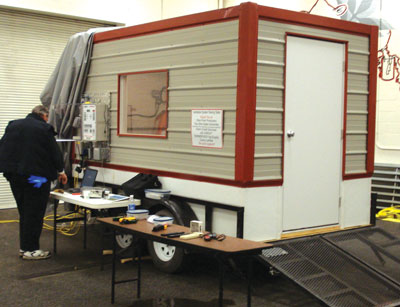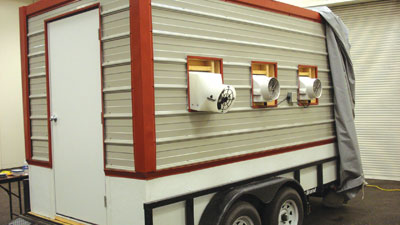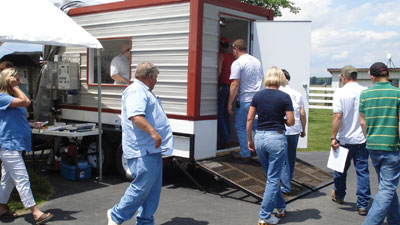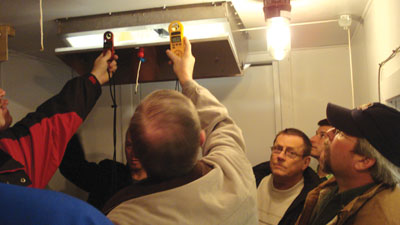
Mobile training unit instructs pork producers on how to better utilize their ventilation systems.
Mobile training unit instructs pork producers on how to better utilize their ventilation systems.
The difficult part about getting a handle on your ventilation system is that air is invisible. In a big barn, it’s hard to see what’s really taking place. Dale Ricker, swine program specialist with Ohio State University Extension, and his colleagues have made it easier to visualize this problem. He and his team have built a trailer that uses smoke to let farmers see up close how to improve their systems.
 |
|
| Ohio State University Extension researchers and specialists have constructed a trailer that uses smoke to let farmers see up close how to improve their ventilation systems.
|
“The trailer was an idea we borrowed from Dr. Mike Brumm who was at the University of Nebraska at the time and Steve Pohl from the South Dakota State University,” explains Ricker. “They really developed the idea of constructing a hands-on training model and have been very successful out west with this concept.”
Building the trailer was a team effort. The $13,000 to construct it came from a number of sources, including: the Ohio Pork Producers Council, Ag Credit, Farm Credit Services of Mid America, Farmer Boy Ag Systems Inc., and other sponsors. Once the funds were raised, the trailer was built in the engineering shop at the Ohio Agricultural Research and Development Center in Wooster, Ohio, under the direction of Dr. Mike Brugger, P.E., Ph.D. It was completed late in 2007.
In January 2008, training began for the instructors. “We invited Dr. Steve Pohl and Dr. Mike Brumm to come train us,” recalls Ricker. “At the same time, we invited some of the producers around Ohio to come in and sit through the training and see the ventilation trailer. As a result of that, the producers saw the potential and scheduled workshops, which we took to their farms.”
Mobile education
Ricker, along with Dr. Brugger and Glen Arnold, an OSU Extension educator, began taking the trailer out to farmers in June.
“The three-hour training workshop begins with a Powerpoint presentation in a classroom setting,” explains Ricker. “We want everyone to understand the principles of ventilation — how air is supposed to flow, what speed it is supposed to flow in inlet, among other things.
“After the classroom portion, we take them out to go through the hands-on portion or the visualizing of what they had just learned.”
In the trailer
 |
|
| The trailer was built with exhaust fans and air inlets, as well as a controller for the fans and inlets, providing livestock and poultry producers with a hands-on education tool. |
The “hands-on” portion takes place at the trailer, which incorporates exhaust fans and air inlets, as well as a controller for the fans and inlets.
The attendees are asked to go through a number of “tasks,” including:
Reviewing common tools for measuring air speed at a swine building’s inlets.
Seeing how common smoke tools show air speed and direction.
Reviewing common tools for measuring relative humidity in swine buildings.
Operating the trailer at low, high and normal static pressure, and using a smoke tube to demonstrate how incoming air reacts under different conditions.
Using a smoke tube to look for unplanned air openings into the ventilation trailer.- Using a manometer to measure various levels of static pressure.
Reviewing the importance of properly operating fan shutters.
Ricker’s goal is to have farmers walk away with the skills to make improvements to their own ventilation systems and experience better performance.
“The whole idea of proper ventilation in a building is to not only create the optimum environment for workers and pigs, but to create the optimum environment to reduce energy costs,” he says. “Proper ventilation will create that optimum zone where pigs will convert feed more efficiently and, as a result of that, they’ll stay healthier. So, potentially it can reduce expenses in terms of antibiotics or treating pigs, as well.”
Custom Classes
Ricker says they try to customize the course as much as possible to meet the needs of the group. “If we’re working with an integrated system, say with their contract growers, we try to modify our presentation so that we’re using inlets and we’re talking about buildings that they operate.”
 |
|
| Producers tour through the portable ventilation trailer during a workshop. The goal of the program is to have farmers walk away with the skills to make improvements to their own ventilation systems and experience better performance. |
Once the workshops are completed, Ricker likes to get an evaluation from the participants. He’s interested in the economic impact this information could have on their farms. “Our most recent evaluation, where 15 producers attended, the economic impact they felt to their operations was in excess of $20,000 — about $1,000 per user. With a $25.00 registration fee, it’s a pretty good return on investment.”
One of the biggest savings the farmers thought they would experience was fuel related. “With rising energy costs — especially propane bills — when you start putting dollar and cent values to energy savings by proper setting of ventilation controls and heater on/off set times, it’s an eye opener,” says Rickers. “Especially if you have larger buildings or your talking about integrated systems with 80 or 100 barns, the savings are huge.”
Responding to a need
The course came about because Ricker says there was lack of knowledge out there on how to operate mechanically ventilated buildings.
“As buildings have gotten larger and controls have gotten a little more sophisticated, I think a lot of people are under the impression that we have this technology and it’s just going to create the perfect environment on its own. But it doesn’t always do that,” he says. “Farmers need to have the know-how to be able to figure out whether it’s performing correctly. That’s hopefully what this training does.”
Ricker and his team were scheduled to take the trailer to farms and other locations throughout the fall. At the time of this interview, they had conducted three and there were two more scheduled.
“We have had interest from several of the surrounding states, but to this point, we’re not really soliciting that very heavily. We want to make sure we offer it to more people in Ohio first,” says Ricker.
Favorable responses
The course is getting favorable responses from attendees. Steve Stitzlein, production supervisor at Heimerl Farms Ltd., near Johnstown, Ohio, brought 60 individuals to attend the “hands-on” ventilation program.
 |
|
| Producers tour through the portable ventilation trailer during a workshop. The goal of the program is to have farmers walk away with the skills to make improvements to their own ventilation systems and experience better performance. |
“We split them into several groups and worked them through, giving them time both inside and outside the trailer. It worked well,” he says. “We have a lot of contract growers that are still learning how to manage their buildings, so our focus was getting them to understand how air flows and that sort of thing. Inside the trailer, they could really observe what goes on in the barns. With the trailer, you can make some adjustments and see what happens as the air comes in — something that’s tough to do in a big barn.”
Stitzlein believes the producers, which represented more than 50 barns, left with information that can improve their bottom line. “Ventilation is important because it affects the pig’s performance. We’re trying to make sure that the ventilation is right so we have maximum performance.”
He’s also hoping they can save a little on fuel. “If farmers over ventilate in the wintertime, then they’re going to use more propane. We want to move enough air in the wintertime, but yet not too much, so that we’re not taking all the heat out and burning a lot of propane.”
In the end, he felt the money spent on the course was well worth it. “The cost was minimal. And if you can train the growers to do a better job, it saves us money in the long run.”
Joe Higgins, sow division manager at Cooper Farms, also had a group of 30 attend the program — both pork producers and turkey breeders. He says both groups walked away better informed.
“We deal with a lot of ventilation in our facilities,” says Higgins. “So any time we can learn a trick or two, it’s nice.”
What Higgins found most helpful was having someone with knowledge about the control panels and seeing the different aspects of the controls when correctly or incorrectly aligned.
“We have an argument every winter about losing money out the fans,” says Higgins. “What happens without the proper control set- ups is that we have the heaters heating the room up, and then the room gets too hot. And then the fans come on, and they suck all the hot air out that you just spent to put in there. So the object’s not to suck the heat out and still ventilate the rooms.”
Cooper Farms now has the ability to track fuel usage and electric costs. Their goal this year, after this ventilation course, is to “knock off about three percent of our winter fuel costs,” says Higgins.
Cooper Farms is also hoping this ventilation knowledge will benefit the animals as well. “If you don’t have proper ventilation, the animals will get sick. And because we have sows and pigs within a room, we’re trying to create two comfort zones — one for the pigs and one for the sows. And it makes it really difficult for us. Proper ventilation is very important.”
Tracking
Since the courses have only been taught this summer and fall, it will take time to find out the real dollar value they’ve had for farmers. But to-date, everyone involved has seen value — even if just to review ventilation basics.
Expect more courses in the future. “We still have integrators that are building new barns. As ventilation controls and technologies change, we will most likely need to update our model. But there will still be a need for education,” says Ricker.